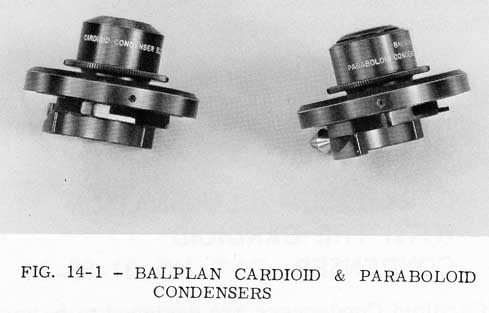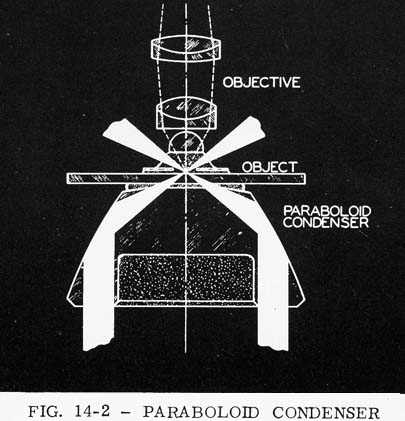SECTION - 14
Dark Field Microscopy
Various means have been developed for
accomplishing Dark Field Illumination. The
device used generally consists of a special
Condenser for the Substage of the Microscope
replacing the Condenser employed for Bright
Field Illumination. It is usually used in
conjunction with a conventional Microscope
Illuminator and provides a hollow, annular
cone of light. The apex of the cone is formed
at the object plane.
In the Balplan Microscope, Dark Field
Illumination is achieved with the Paraboloid
Condenser, Cat. No. 31-55-33, or the
Cardioid Condenser, Cat. No. 31-55-34,
Fig.14-1.
Successful Dark Field Illumination requires
a light source of high intensity. Sky
light and the light provided by frosted lamps
of the common variety are inadequate. The
Balplan High Intensity Base Illuminator
provides ample illumination for dark field
use with either the Paraboloid or Cardioid
Condenser and has the advantage of being
a built-in aligned unit.
DARK FIELD ILLUMINATION
WITH THE PARABOLOID
CONDENSER, CAT. NO. 31-55-33

Paraboloid Condensers are primarily designed
to be used with a medium to high
power Objective.
The principle of the Paraboloid Condenser
is illustrated in Fig. 14-2. Parallel
light passes around the opaque central stop,
is reflected at the parabolic surface, and
exits through the upper piano surface into
the object slide. For optimum results
(achieving maximum contrast between object
detail and background) the object plane must
coincide with the point of focus of the
Paraboloid Condenser. Light passes through
this point under angles equal to numerical
aperture limits of 1.20 to 1.37. Since the
N.A. limits are greater than 1.00, it is
always necessary to maintain oil contact
between the Condenser and object slide.
Furthermore, to realize the dark field
image, it becomes necessary to use an
Objective with an N.A. of less than 1.24.
 This necessitates the 100X 1.25 N.A.
Objective be used with a Funnel Stop. A
Funnel Stop is a fixed Diaphragm designed
to reduce the N.A. of an Objective. A special
wrench is supplied with the Funnel Stop
to aid in its installation. The two prongs of
the wrench fit the slots in the Diaphragm
at the top (Nosepiece end) of the Objective.
Unscrew the Diaphragm from the Objective,
turning the wrench counterclockwise as for
a normal screw thread. Replace the Dia-
phragm with the Funnel Stop, using the
wrench to tighten it into place. When
returning to bright field use of the Objective,
remove the Funnel Stop and replace it with
the standard Diaphragm.
This necessitates the 100X 1.25 N.A.
Objective be used with a Funnel Stop. A
Funnel Stop is a fixed Diaphragm designed
to reduce the N.A. of an Objective. A special
wrench is supplied with the Funnel Stop
to aid in its installation. The two prongs of
the wrench fit the slots in the Diaphragm
at the top (Nosepiece end) of the Objective.
Unscrew the Diaphragm from the Objective,
turning the wrench counterclockwise as for
a normal screw thread. Replace the Dia-
phragm with the Funnel Stop, using the
wrench to tighten it into place. When
returning to bright field use of the Objective,
remove the Funnel Stop and replace it with
the standard Diaphragm.
A word of caution - the top lens is
somewhat exposed when the Diaphragms are
removed. Care should be exercised to avoid
touching this surface.
DARK FIELD ILLUMINATION
WITH THE CARDIOID
CONDENSER, CAT. NO. 31-55-34

Cardioid Condensers are designed to be used
primarily with a high power Objective. The
principle of the Cardioid Condenser is
illustrated in Fig. 14-3. It is a reflecting
form of Condenser, free from both chromatic
and spherical aberrations. By virtue of
the curved reflecting surfaces, the rays
of parallel light entering around the central
stop are formed into a hollow cone and
brought to a mathematically correct focus.
Light passes through the point of focus
of the Cardioid Condenser under angles
equal to numerical aperture limits of 1.20
to 1.39.
As with the Paraboloid Condenser, in
order to achieve a dark field image, an
Objective with an N.A. of less than 1.20
must be used. Oil contact between Cardiod
Condenser and the object slide is
also required.
MOUNTING CONDENSERS
To mount the Paraboloid or Cardioid
Condenser to the Substage, rack the Sub-
stage down. The Condenser will snap in
place by pushing the Key on the Condenser
into the spring-loaded plunger in the back
of the Substage.
The Bodies of these Condensers are
threaded and are provided with a lock ring,
so that its height in the Substage may be
adjusted and the Condenser locked in place.
If the Substage Stop was previously set for
Bright Field Illumination, rack the Substage
up to its highest position and adjust the
Condenser vertically by screwing the
threaded portion up or down until the top of
the Condenser is just below the top of the
Microscope Stage. Then, lock it in place by
means of the lock ring. This will allow you
to interchange Bright Field and Dark Field
Condensers without adjustment of the Sub-
stage stops.
Two Substage Centering Screws are
supplied with the Dark Field Condensers,
Fig. 14-4. If your Substage is not already
equipped with Centering Screws, Cat. No.
313214-198, the Set Screws, Fig. 14-4,
should be replaced with the Centering Screws
supplied with the Condenser. Use the
Hexagonal Wrench supplied to remove the
Set Screws.

By means of the two Centering Screws,
adjust the Condenser until its top is
centered in the Stage opening. Select a
specimen slide no thicker than 1.35mm.
Make sure that the slide is clean. Mount
the material to be examined on it and
cover it with a #1-1/2 Cover Glass.
Place a generous drop of oil on the
Condenser and lower it slightly below
the surface of the Microscope Stage by
racking the Substage down. Place the slide
on the Stage and rack the Condenser up
until oil contact with the slide is made. Use
a 10X Objective and focus on the specimen.
Focus the Condenser up and down by means
of the Substage Rack and Pinion until the
smallest spot of light is seen in the field.
If your Illuminator has an Iris Diaphragm,
open the Diaphragm completely. Make final
centering adjustments of the Condenser by
means of the Centering Screws, Fig. 14-4.
Having completed the above adjustments,
all that remains in order to proceed with
dark field observations is to substitute the
desired high power Objective for the 10X
Objective used for centering purposes.
OBJECT SLIDES AND COVER GLASS
FOR DARK FIELD MICROSCOPY
Slides for use with the Dark Field Con-
densers must be no thicker than 1.35mm.Thinner slides are more desirable since
some focal adjustment of the Condenser is
permitted. Slides thinner than 1.0mm may,
however, cause trouble through difficulty
in maintaining adequate oil contact between
the Condenser and the slide. Specimen slides
vary in thickness in any one box. One
should select slides by actually measuring
them with a micrometer caliper. The cover
glass should also be carefully measured if
it is intended to use a "high dry" Objective.
The cover glass for such an Objective
should be selected for 0.18 + 0.05mm thick-
ness. The cover glass thickness is of less
importance when an oil immersion Objective
is employed. However, the maximum thick-
ness that can be readily accommodated with
an oil immersion Objective is about 0.2mm.
Slides and cover glasses must be
scrupulously clean and free from pits,
scratches and similar defects. It is best to
measure and select a number of slides and
cover glasses at one time and reserve them
for dark field work. Slides of optical quality
fused quartz, ground and polished to the
desired thickness, are available and are
recommended for use. This is particularly
important for ultramicroscopy with the Cardioid
Condenser.
SPECIMEN PREPARATION
CAUTION:
Do not put a thick or highly
concentrated suspension on the
slide. Be sure not to have too
much solid material in the preparation.
Best dark field results
will be obtained from mounts
which appear void to the unaided eye.
Place a drop of the solution to be
examined on the slide, cover with a cover
glass and blot off any excess liquid with
absorbent cotton, filter or blotting paper.
OBJECTIVES FOR DARK FIELD
The best results are obtained when using a
Paraboloid or Cardioid Condenser if theN.A. of the Objective is not more than 1.0.
The Balplan 10X, 0.25 N.A.; 20X, 0.50 N.A.;
and 40X, 0.65 N.A. Objectives are suitable.
If higher magnification is required, the
Balplan 100X, 1.25 N.A. Objective should be
employed, along with its appropriate Funnel
Stop, Cat. No. 31-51-71.
Be sure the Objective does not have old
immersion oil on the tip. Clean it carefully,
Place a drop of oil on the cover slip, taking
care to prevent the formation of bubbles.
Cargille's Immersion Oil is recommended,
It can be readily wiped off an Objective or
slide with lens tissue and a very little
solvent such as toluol or xylene. It is better
than cedarwood oil in this respect and is,
in addition, non-drying, non-fluorescing,
colorless and has the proper refractive
index for glass.
Raise the Stage until the oil drop contacts
the tip of the Objective. Look into the
Eyepiece(s) and carefully focus the Microscope
using the fine adjustment until the
specimen preparation is seen clearly.
If brilliantly-illuminated circles are
observed, the cause may be air bubbles in
the preparation, in the oil below the slide,
or in the oil above the slide. When focusing
any instrument used with immersion oil,
always turn the Fine Adjusting Knob slowly
to avoid drawing bubbles into the oil.
After use, wipe the oil off the Condenser
and Objective with cotton or lens tissue.
Back - Section 13
Forward - Section 15
 This necessitates the 100X 1.25 N.A.
Objective be used with a Funnel Stop. A
Funnel Stop is a fixed Diaphragm designed
to reduce the N.A. of an Objective. A special
wrench is supplied with the Funnel Stop
to aid in its installation. The two prongs of
the wrench fit the slots in the Diaphragm
at the top (Nosepiece end) of the Objective.
Unscrew the Diaphragm from the Objective,
turning the wrench counterclockwise as for
a normal screw thread. Replace the Dia-
phragm with the Funnel Stop, using the
wrench to tighten it into place. When
returning to bright field use of the Objective,
remove the Funnel Stop and replace it with
the standard Diaphragm.
This necessitates the 100X 1.25 N.A.
Objective be used with a Funnel Stop. A
Funnel Stop is a fixed Diaphragm designed
to reduce the N.A. of an Objective. A special
wrench is supplied with the Funnel Stop
to aid in its installation. The two prongs of
the wrench fit the slots in the Diaphragm
at the top (Nosepiece end) of the Objective.
Unscrew the Diaphragm from the Objective,
turning the wrench counterclockwise as for
a normal screw thread. Replace the Dia-
phragm with the Funnel Stop, using the
wrench to tighten it into place. When
returning to bright field use of the Objective,
remove the Funnel Stop and replace it with
the standard Diaphragm.


